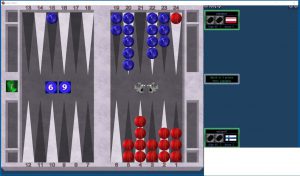Background
For years I’ve felt backgammon has lost some of it’s appeal with the computers teaching us how badly we really play. Sure, there are some variants like Nackgammon but I needed something different. Something that also addresses the needs of casual players, effectively making play as much fun and rejuvenated as when they first learned to play. In the end I tested out one simple change that I thought would generate more than the changes it did, which were, in fact, almost none. The end result is basically one rule change and a few clarifications.
Goal
To create a variant of backgammon that is easily playable and still different enough to both be fun and thought inspiring. It is important to notice that the goal is not to create something very different to backgammon but to keep the changes to an absolute minimum while still attracting players (also those who have left).
Requirements
1 d10 dice (dice with 10 sides instead of 6), preferably per player
Rule changes (with comments)
A player rolls one 1d6 and one 1d10 dice.
At start both players roll the 1d6 dice.
(and the rest is not required, it just mostly clarifies the rules stay the same)
Your home still consists of 6 points.
Bearing off is not allowed until all your men are in your home.
Coming in from the bar is only allowed into your opponents home.
It is still possible to get doubles (11-66), they are just less common.
It is now possible to get “long longshots” (13-16).
Normal backgammon notation still works (no need to change it as 10 is the only one that looks weird as it’s shown as a “0” on d10 dice but you get used to it quite fast).
And finally the obligatory Youtube videos for the illiterate
Youtube reference game (3+3+7p matches, 1.30h, timed positions for a fast have-a-look)
Youtube reference game (5p, several basic gotchas, 0.30h, timed positions for a fast have-a-look)
Just to check who reads past Youtube references these days… A common position, simply showing you can get the typical backgammon horror rolls in Eskgammon too. Except there are quite a lot more of them, which means minimizing damage is much more difficult or even impossible at times.

Quotes
Apart from the main quote above I think this one summarizes it as far as the original idea goes.
“i play for fun, never studied bg books or used analyze tools in bg and eskgammon is much more fun 🙂“
(quote from one of the first Eskgammon converts, with us from the start, after almost 10 years of playing)
Mission accomplished (*).
Unfortunately there was a small side effect. Eskgammon is (way?) more competitive than normal backgammon. At first we thought it was due to the money game format suiting Eskgammon so well but after adjusting the swing tournament format to match play, mind you, I caved in (designing the addition) after more than five years saying it could not be done well… as of 2018, swing match tournaments work as well as normal ladders with the added benefit of a known tournament finish time!
(*)
So, Eskgammon is just for kids? Wrong. This is one of the first impressions you hear until people have played enough (not many games/matches needed).
More importantly, you can play it for fun. But if you want to play it competitively, be it money, match, swing, chouette or any ladder format, it works just fine. You just have to use your brain instead of botting away.